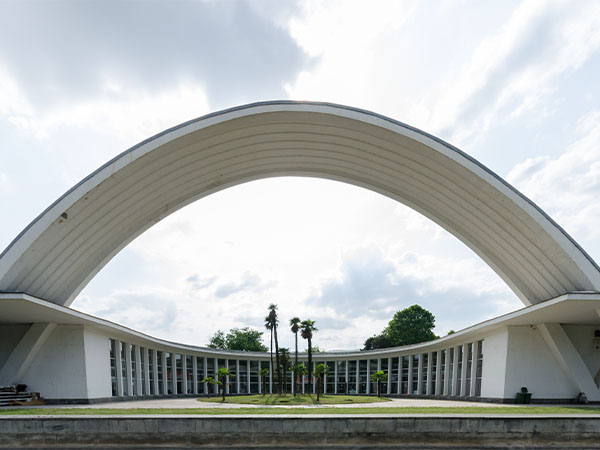The exhibit, Beyond the Ruin: Soviet Georgian Architecture in Context, examines the cultural legacy of Georgian architecture in the late Soviet period—often known as the Era of Stagnation. The era of aging bureaucrats, stifling censorship, and that most potent symbol of crushing conformity: drab concrete housing. Today, Soviet buildings are frequently presented as ruins, reduced to little more than poignant symbols of a failed empire and crushed dreams of socialist utopia. Georgia’s lively Soviet designs, then, may come as a surprise. They are, at first glance, the wrong buildings in the wrong places at the wrong time: custom designs in the age of prefabrication, Soviet celebrations of Georgian national heritage, cultural innovations in an era remembered largely for inertia.
These structures appear to be anachronisms largely because the way we currently view Soviet architecture obscures the diverse ways architectural history unfolded behind the Iron Curtain after Stalin. The rise of “ruin porn”—fetishized images of abandoned Soviet buildings—has stripped Soviet architecture of its history and geography. Neither architect nor location nor chronology matter; Soviet architecture as a symbol has eclipsed Soviet architecture as a lived reality. That reality may have produced monotonous workers’ housing, but it also underwrote bold experimentation that varied widely across decades and republics.
This creative ferment was particularly pronounced in Georgia, a small peripheral republic that punched well above its weight culturally, in large part thanks to self-styled patron of the arts Eduard Shevardnadze, First Secretary of the Georgian Communist Party as of 1972. Shevardnadze made good use of Leonid Brezhnev’s “developed socialism,” a reinterpretation of Marxism that emphasized the present quality of life over a future utopia. Although Georgia was far from Moscow’s oversight, Shevardnadze still had access to its coffers and so was able to foster a cosmopolitan atmosphere in which architects were free to draw inspiration from both national and international influences. This porousness of the Iron Curtain can be seen as architects increasingly broke from the dictates of mid-century modernism by combining foreign and local, historical and contemporary elements. The buildings captured in these photographs speak to this trajectory as it occurred in Georgia and in doing so provide the context so often lacking in images of ruin.
About the Artists
Angela Wheeler has worked in the Georgian heritage sector since 2010. She graduated from Columbia University in 2016 with an MS in Historic Preservation and a certificate from the Harriman Institute.
Vladimer Shioshvili is a Georgian-American photographer who documents street art and urban transformation in Tbilisi. Vladimer began photographing Soviet architecture with Angela in summer 2015, when she started her thesis research on the architect Victor Jorbenadze. They have photographed over sixty sites.


